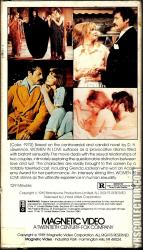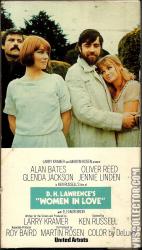Women in Love
Catalog Number
4576-30
-
Primary Distributor (If not listed, select "OTHER")
Catalog Number
4576-30
Primary Distributor (If not listed, select "OTHER")
Release Year
Country
129 mins (NTSC)
N/A | N/A | N/A
N/A | N/A
Second Distributor
Women in Love (1970)
Additional Information
Additional Information
The relationship between four sensual people is limited: They must find a new way.
Women in Love is set in 1920s England, where free-spirited artist Gudrun (Glenda Jackson) and her schoolteacher sister Ursula (Jennie Linden) make the acquaintance of lifelong friends Gerald (Oliver Reed) and Rupert (Alan Bates). The foursome attends a picnic in honor of a pair of newlyweds, who put a damper on the proceedings (literally!) by drowning in a nearby lake. Evidently unscathed by this tragedy, Gerald and Rupert participate in a nude wrestling match later that evening (this was the sequence that got the most press, thanks to fleeting glimpses of the male stars' privates). Gerald marries Gudrun, Rupert weds Ursula, and the foursome embarks upon a Swiss honeymoon. The holiday is marred by infidelity and sudden death, leaving Rupert to wonder aloud just what it is that makes men and women "tick." An Academy Award went to Glenda Jackson, while nominations were bestowed upon screenwriter Larry Kramer and cinematographer Billy Williams (who received an uncredited assist from director Ken Russell).
Women in Love is a 1969 British romantic drama film directed by Ken Russell and starring Alan Bates, Oliver Reed, Glenda Jackson, and Jennie Linden. The film was adapted by Larry Kramer from D. H. Lawrence's novel of the same name.[3]
The plot follows the relationships between two sisters and two men in a mining town in post First World War England.[4] The two couples take markedly different directions exploring the nature of commitment and love.
The film was nominated for Best Cinematography, Best Director and Best Writing, Screenplay Based on Material from Another Medium. Jackson won the Academy Award for Best Actress for her role, as well as a slew of critics' honours.
Released in Britain in 1969 and the US in 1970, the film was applauded as a good rendering of D.H. Lawrence's once controversial novel about love, sex and the upper class in England. During the making of the film, Russell had to work on conveying sex and the sensual nature of Lawrence's book. Many of the stars came to understand this was to be a complex piece and worked hard to convey this. No one worked as hard as Oliver Reed, who would do a nude wrestling scene with Alan Bates. He went as far as to persuade (and lightly physically arm twist) director Russell to film the scene. Russell conceded and shot the controversial scene, which suggested the homoerotic undertones of Gerald and Rupert's friendship. The wrestling scene caused the film to be banned altogether in Turkey. The composer Michael Garrett who also contributed to the score can be seen playing the piano in one scene. Considered the best of Russell's films, it led him to adapt Lawrence's prequel The Rainbow (1989).
The film was one of the eight most popular films at the British box office in 1970.
Release Date: March 25, 1970 @ The Fine Arts
Distrib: United Artists
Women in Love is set in 1920s England, where free-spirited artist Gudrun (Glenda Jackson) and her schoolteacher sister Ursula (Jennie Linden) make the acquaintance of lifelong friends Gerald (Oliver Reed) and Rupert (Alan Bates). The foursome attends a picnic in honor of a pair of newlyweds, who put a damper on the proceedings (literally!) by drowning in a nearby lake. Evidently unscathed by this tragedy, Gerald and Rupert participate in a nude wrestling match later that evening (this was the sequence that got the most press, thanks to fleeting glimpses of the male stars' privates). Gerald marries Gudrun, Rupert weds Ursula, and the foursome embarks upon a Swiss honeymoon. The holiday is marred by infidelity and sudden death, leaving Rupert to wonder aloud just what it is that makes men and women "tick." An Academy Award went to Glenda Jackson, while nominations were bestowed upon screenwriter Larry Kramer and cinematographer Billy Williams (who received an uncredited assist from director Ken Russell).
Women in Love is a 1969 British romantic drama film directed by Ken Russell and starring Alan Bates, Oliver Reed, Glenda Jackson, and Jennie Linden. The film was adapted by Larry Kramer from D. H. Lawrence's novel of the same name.[3]
The plot follows the relationships between two sisters and two men in a mining town in post First World War England.[4] The two couples take markedly different directions exploring the nature of commitment and love.
The film was nominated for Best Cinematography, Best Director and Best Writing, Screenplay Based on Material from Another Medium. Jackson won the Academy Award for Best Actress for her role, as well as a slew of critics' honours.
Released in Britain in 1969 and the US in 1970, the film was applauded as a good rendering of D.H. Lawrence's once controversial novel about love, sex and the upper class in England. During the making of the film, Russell had to work on conveying sex and the sensual nature of Lawrence's book. Many of the stars came to understand this was to be a complex piece and worked hard to convey this. No one worked as hard as Oliver Reed, who would do a nude wrestling scene with Alan Bates. He went as far as to persuade (and lightly physically arm twist) director Russell to film the scene. Russell conceded and shot the controversial scene, which suggested the homoerotic undertones of Gerald and Rupert's friendship. The wrestling scene caused the film to be banned altogether in Turkey. The composer Michael Garrett who also contributed to the score can be seen playing the piano in one scene. Considered the best of Russell's films, it led him to adapt Lawrence's prequel The Rainbow (1989).
The film was one of the eight most popular films at the British box office in 1970.
Release Date: March 25, 1970 @ The Fine Arts
Distrib: United Artists
Related Releases2
Catalog Number
4576
Primary Distributor (If not listed, select "OTHER")
Women in Love (1970)
Release Year
Catalog Number
4576
Primary Distributor (If not listed, select "OTHER")
Catalog Number
4576
Catalog Number
M206121
Primary Distributor (If not listed, select "OTHER")
Women in Love (1970)
Release Year
Catalog Number
M206121
Primary Distributor (If not listed, select "OTHER")
Catalog Number
M206121












Comments0
Login / Register to post comments